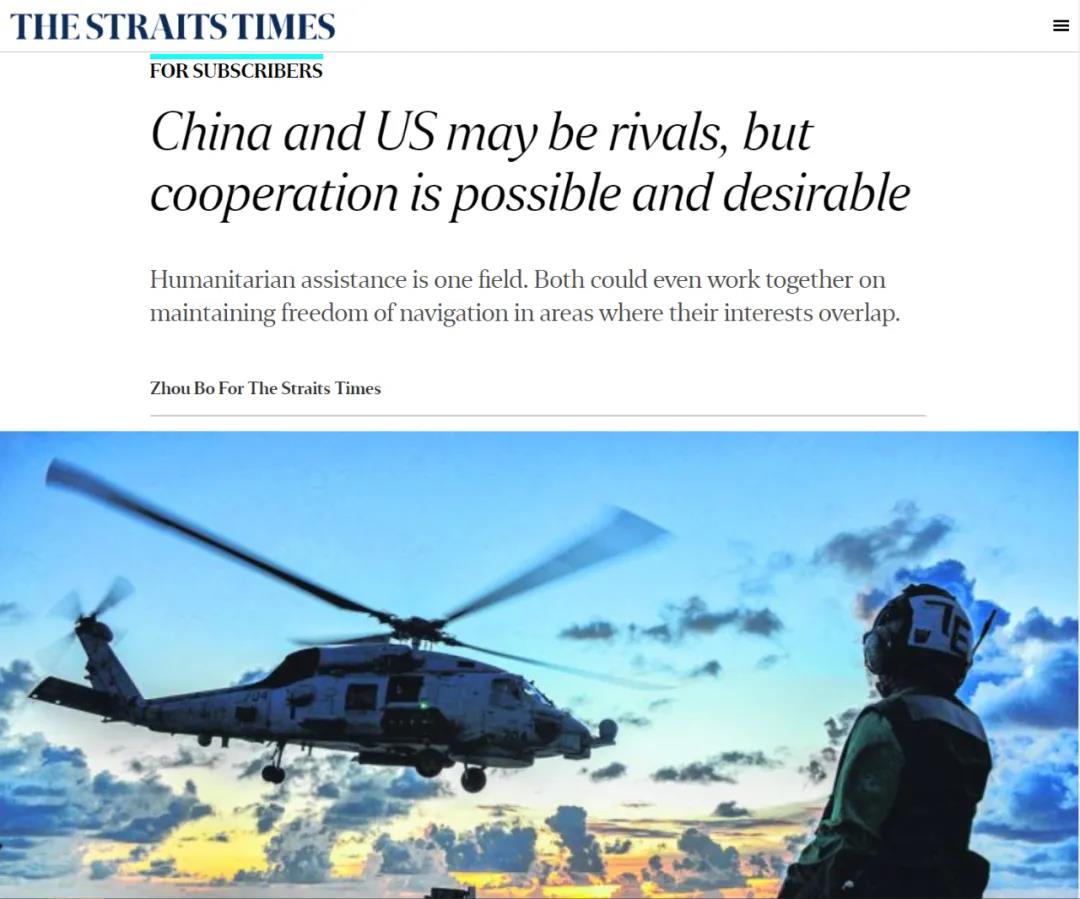Senior Colonel (Ret) Zhou Bo is a senior fellow at the Centre for International Security and Strategy, Tsinghua University, and a China Forum expert.

That Mr Joe Biden will soon occupy the White House instead of Mr Donald Trump will not necessarily elicit sighs of relief in Beijing. However different Mr Biden might be from Mr Trump personally, the great power competition initiated by the Trump administration and backed by a bipartisan congressional consensus will not only remain on course but also likely intensify in the decades to come.
Of course, nothing is more worrisome than a military conflict between two nuclear powers, but this is not impossible, given rising tensions in the Taiwan Straits and the South China Sea.
Although the People's Liberation Army's (PLA) military strength lags behind that of the US military in general, in the West Pacific, the gap is closing in China’s favour. In November 2018, the bipartisan National Defence Strategy Commission set up by the US Congress warned that in a war with China over Taiwan, “Americans could face a decisive military defeat”.
Neither China nor the US wants a war. Both have a few agreements on confidence building measures such as the Military Maritime Consultative Agreement and the Rules of Behaviour for Safety of Air and Maritime Encouters and hotlines both at governmental and military levels. But the fact remains that accidents can happen, as with the deadly collision of a United States Navy surveillance plane with a Chinese fighter jet off Hainan in 2001. There have also been quite a few close encounters between American and Chinese military vessels and aircraft, in 2001, 2009, 2013, 2014, 2015 and 2018.
Could the two countries prevent an accident spilling over into a conflict neither wants to see? In this regard, the setup and the first round of talks of the Crisis Communications Working Group between the Chinese Ministry of National Defence and US Department of Defence in late October is a move in the right direction. It’s the first time both sides acknowledged that a crisis could break out between them.
COOPERATION IN GLOBAL COMMONS
For China and the US to deconflict, the way forward is to look beyond the Western Pacific into the global commons where their common interests overlap. Away from China’s near sea, the two are not at loggerheads and cooperation is entirely possible.
China-US cooperation could even help to mitigate their longstanding disagreements on, say, freedom of navigation. While Beijing opposes the US Navy's freedom of navigation operations in the South China Sea and waters close to its shores, seeing them as a threat to China's security, things are different in places such as the Gulf of Aden, where the two navies have joined other international navies in counterpiracy patrols to maintain freedom of navigation.
As 90 per cent of international trade is seaborne, China, being the largest exporter and the second-largest importer in the world, has vital interests in the security of international sea lanes, like the US.
If the Chinese and American navies can cooperate successfully in the Gulf of Aden, why not extend such cooperation to, say, the high seas of the Gulf of Guinea and the Sulu Sea, where piracy is still rampant?
In fact, as China goes global, it finds itself sharing increasingly common interests with the US.
China has said previously and it bears repeating here, that it has no intention to replace the US as a world leader or global cop. Nor does it seek to export its ideology or development model.
Much has been made of the growth of the PLA Navy, which today outnumbers the US Navy in ships and submarines. Its vessels are more than enough to solve China's Taiwan or South China Sea issues, but it is important to note that the push to build a blue water navy is a necessary move to protect China's ubiquitous investments, commercial assets and nationals overseas. It also enables China to shoulder the international obligations that are incumbent upon a major power.
Another area where the PLA and the US military could cooperate is in humanitarian missions. During the Obama administration when Mr Biden was vice-president, both countries discussed providing joint assistance to African peacekeepers, but the talks were scrapped after Mr Trump took office in 2017.
There is much scope for Sino-US cooperation, including ones that seem non-military but are indeed security-related. For example, in 2014, Chinese and American scientists worked side by side in a Chinese laboratory on Ebola in Sierra Leone. The spread of Covid-19 with a death toll of over 1.6 million people worldwide shows clearly how “non-traditional” threats such as pandemics could be far more lethal even than a major war and, more importantly, why the two major powers should join hands once again.
WORK NEEDED IN THESE AREAS
As the gap between the Chinese and the US militaries shrinks, the day will come when they have to discuss strategic equilibrium.
The US now wants a multilateral nuclear disarmament agreement involving China, the US and Russia. China will not agree to this given how lopsided the deal would likely be. Both the US and Russia have over 6,000 nuclear warheads each. Even if the number of warheads on China's land-based intercontinental ballistic missiles capable of reaching the United States grow to roughly 200 in the next five years, as the Pentagon predicted in its report to Congress this year, such an American proposal to China sounds like a fat man inviting a lean man to go on a diet together.
On the nuclear issue, would it not be better if China and the US moved to discuss non-first use of nuclear weapons, as Beijing has proposed? No-first-use won't reduce the overall superiority of the US in both nuclear and conventional forces. Even though Beijing has vowed to build a "world-class military" by the mid-century, it would take the PLA another 30 years to come close to matching the US military, according to Beijing's own road map.
But in new military domains such as cyberwarfare, space and artificial intelligence, the gap between the PLA and the US military is smaller. But for China and the US to even start talking about these issues, the US has to lift the legal restrictions on exchanges with the PLA first.
Since 2000, American laws have restricted exchanges with the PLA in operational areas for fear that they might contribute to the PLA’s war-fighting capabilities and “create a national security risk”.
But the tremendous progress of the PLA in the last two decades demonstrates that it doesn't necessarily need exchanges with the US military to grow in strength. According to the Pentagon, "China is already ahead of the United States in certain areas" such as in ship building, land-based conventional ballistic and cruise missiles and integrated air defence systems.
It would be most unfortunate if both China and the US were to slide into a new cold war. Even if the mood in Washington is one for big power competition, both sides must strive to avoid the contest sliding into confrontation, and the way to do so is still cooperation, looking for it and engaging in it wherever the opportunity arises.

